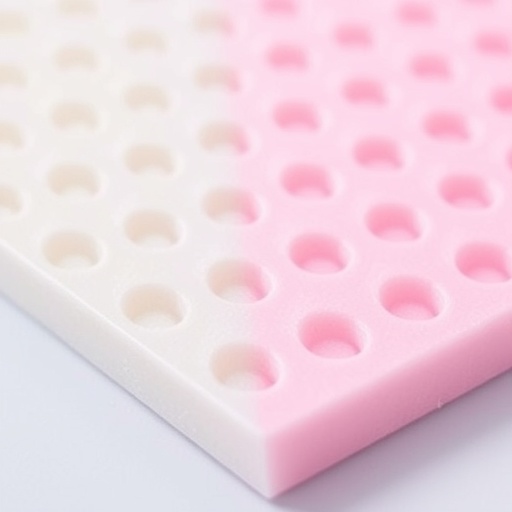In the rapidly evolving field of additive manufacturing, the quest for seamlessly integrating dissimilar materials into a single 3D printed object has become a pivotal challenge. Recent research spearheaded by Donoughue, Lumpp, Pakulski, and their colleagues sheds light on the fundamental role that material properties and surface topography play in dictating the adhesion strength between thermoplastics and elastomeric interfaces. Their findings, published in npj Advanced Manufacturing, promise to revolutionize how engineers and designers approach the joining of diverse materials in multi-material 3D printing applications.
Dissimilar material 3D printing holds tremendous potential for creating complex structures that combine the rigidity of thermoplastics with the flexibility and resilience of elastomers. However, the mechanical reliability of these hybrid constructs hinges critically on the adhesion at the interface. Poor adhesion not only compromises structural integrity but also limits the functional versatility that can be achieved. This groundbreaking study dives deep into the interplay between material composition and microscale surface roughness to unravel the adhesion mechanisms governing these challenging interfaces.
The heart of this research lies in the meticulous examination of how varying the chemical and physical properties of thermoplastics influence their bonding to elastomeric materials. Thermoplastics, favored for their mechanical strength, thermal stability, and ease of processing, often have inherent incompatibilities with the elastic, soft, and often highly deformable nature of elastomers. The investigation delineates how different thermoplastic chemistries modulate interfacial adhesion forces, opening pathways toward optimizing formulations for improved bonding.
Surface roughness emerges as a critical parameter, serving not merely as a passive characteristic but as an active contributor to adhesion strength. By engineering the surface topography of thermoplastic layers through controlled 3D printing parameters and post-processing treatments, the researchers demonstrate significant modulation in interfacial adhesion. At the microscale, increased roughness enhances mechanical interlocking, elevating the load-bearing capacity of the interface under mechanical stress.
The authors employed advanced characterization techniques to quantify surface roughness parameters—such as average roughness (Ra), root mean square roughness (Rq), and peak-to-valley height—and correlated these with adhesion strength measured through standardized lap shear tests. Their systematic approach revealed a nuanced relationship: while moderate roughening benefits adhesion by increasing surface area and mechanical interlocking, excessive roughness can introduce stress concentrators, paradoxically weakening the joint.
Exploring the thermodynamics of the interface, the study delves into wetting behavior and interfacial free energy considerations. Proper wetting of the elastomer onto the thermoplastic surface is paramount for molecular-level adhesion. By manipulating surface chemistry to adjust polarity and surface energy, the researchers illustrate how the balance between chemical affinity and surface roughness dictates the ultimate adhesion performance.
Moreover, the paper highlights the innovative use of surface modification techniques such as plasma treatment and chemical etching to tailor the thermoplastic surface before elastomer deposition. These modifications not only affect roughness but can introduce functional groups that improve chemical bonding, thereby synergistically enhancing adhesion beyond what physical roughness alone can achieve.
In practical terms, the findings carry profound implications for manufacturing sectors reliant on hybrid structures — from aerospace components requiring durable yet flexible seals, to biomedical devices that must integrate soft tissue-compatible materials with rigid frameworks. The ability to fine-tune interfacial properties means manufacturers can better predict and engineer the lifespan and reliability of their multi-material products.
Importantly, the study also addresses the printing parameters’ influence, noting that layer thickness, print speed, and extrusion temperature impact the resulting surface roughness and consequently, adhesion. By optimizing these parameters, additive manufacturing processes can be calibrated to produce interfaces with superior bonding without necessitating additional processing steps.
One of the more novel insights from this investigation is the identification of an optimal roughness regime specific to each thermoplastic-elastomer pair, indicating that adhesion optimization is material-pair dependent rather than universal. This specificity underscores the necessity for tailored approaches in designing multi-material printing protocols.
The authors also recognize challenges in scaling these findings from laboratory settings to industrial manufacturing. Variability in ambient conditions, printer hardware, and feedstock batches can influence surface properties, necessitating robust quality control systems to ensure reproducibility of adhesion outcomes.
From a scientific standpoint, this work bridges a critical knowledge gap by combining materials science, surface engineering, and mechanical testing to present a holistic view of adhesion at thermoplastic-elastomer interfaces. The multi-disciplinary methodology sets a new benchmark for future research in multi-material additive manufacturing.
Looking forward, the research team suggests avenues for further exploration, including real-time monitoring of interface formation during printing and the use of machine learning models to predict adhesion based on process parameters and surface characteristics. Such advancements could accelerate the development of next-generation 3D printed devices with unprecedented functional complexity.
In conclusion, by meticulously dissecting the roles of both material chemistry and surface roughness, this research illuminates the path toward more reliable, high-performance multi-material 3D printed structures. As additive manufacturing cements its role in industrial innovation, understanding and controlling interfacial adhesion at the granular level will be indispensable for unlocking the full potential of this transformative technology.
This study represents not only a scientific milestone but also a practical guidebook for engineers seeking to harness the power of hybrid materials in additive manufacturing. With these insights, the marriage of thermoplastics and elastomers in 3D printing is poised to move from a technical hurdle to a design strength, fundamentally enhancing the capabilities of manufactured products in myriad applications.
Subject of Research:
Adhesion mechanisms and the effects of material properties and surface roughness on the bonding strength between thermoplastic and elastomeric interfaces in dissimilar material 3D printing.
Article Title:
Material and surface roughness effects on adhesion of thermoplastic-elastomeric interfaces for dissimilar material 3D printing.
Article References:
Donoughue, M., Lumpp, C., Pakulski, J. et al. Material and surface roughness effects on adhesion of thermoplastic-elastomeric interfaces for dissimilar material 3D printing. npj Adv. Manuf. 2, 12 (2025). https://doi.org/10.1038/s44334-025-00023-2
Image Credits: AI Generated




